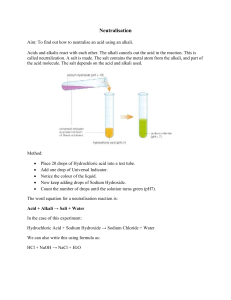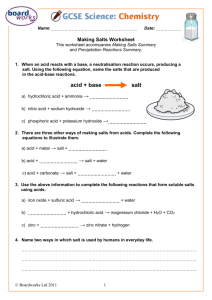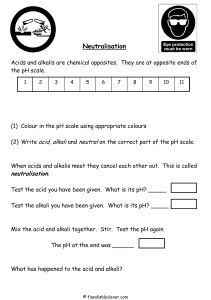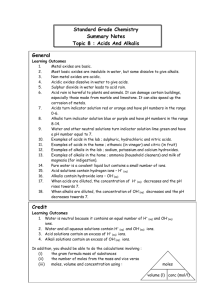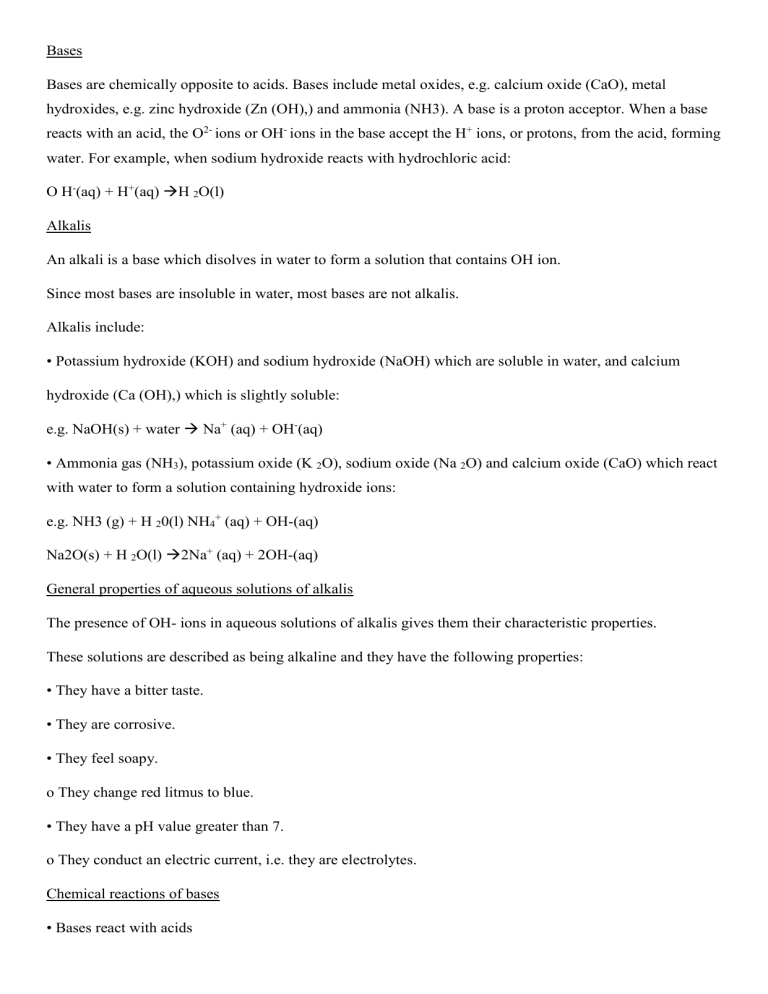
Bases Bases are chemically opposite to acids. Bases include metal oxides, e.g. calcium oxide (CaO), metal hydroxides, e.g. zinc hydroxide (Zn (OH),) and ammonia (NH3). A base is a proton acceptor. When a base reacts with an acid, the O2- ions or OH- ions in the base accept the H+ ions, or protons, from the acid, forming water. For example, when sodium hydroxide reacts with hydrochloric acid: O H-(aq) + H+(aq) H 2O(l) Alkalis An alkali is a base which disolves in water to form a solution that contains OH ion. Since most bases are insoluble in water, most bases are not alkalis. Alkalis include: • Potassium hydroxide (KOH) and sodium hydroxide (NaOH) which are soluble in water, and calcium hydroxide (Ca (OH),) which is slightly soluble: e.g. NaOH(s) + water Na+ (aq) + OH-(aq) • Ammonia gas (NH3), potassium oxide (K 2O), sodium oxide (Na 2O) and calcium oxide (CaO) which react with water to form a solution containing hydroxide ions: e.g. NH3 (g) + H 20(l) NH4+ (aq) + OH-(aq) Na2O(s) + H 2O(l) 2Na+ (aq) + 2OH-(aq) General properties of aqueous solutions of alkalis The presence of OH- ions in aqueous solutions of alkalis gives them their characteristic properties. These solutions are described as being alkaline and they have the following properties: • They have a bitter taste. • They are corrosive. • They feel soapy. o They change red litmus to blue. • They have a pH value greater than 7. o They conduct an electric current, i.e. they are electrolytes. Chemical reactions of bases • Bases react with acids Bases react with acids to produce a salt and water. • Bases react with ammonium salts When heated, bases react with ammonium salts to produce a salt, ammonia and water. Distinguishing between acids and alkalis Indicators are used to distinguish between acids and alkalis in aqueous solutions. An indicator has one colour in an acidic solution and another colour in an alkaline solution. Indicator Colour in an acidic solution Colour in an alkaline solution Litmus Red Blue Methyl orange Red Yellow Screened methyl orange Red Green phenolphthalein Colorless Pink The strength of acids and alkalis The strength of an acid or alkali depends on the degree of ionisation which occurs when they dissolve in water. • A strong acid is fully ionised when dissolved in water. All of the acid molecules ionise and the concentration of H+ ions in the solution is high. Hydrochloric acid (HCI), sulfuric acid (H2SO) and nitric acid (HNO) are strong acids. • A weak acid is only partially ionised when dissolved in water. The solution contains a mixture of acid molecules and H+ ions, and the concentration of H+ ions in the solution is low, e.g. ethanoic acid (CH3COOH). • A strong alkali is fully ionised when dissolved in water. The concentration of OH- ions in the solution is high. Potassium hydroxide (KOH) and sodium hydroxide (NaOH) are strong alkalis. • A weak alkali is only partially ionised when dissolved in water. The concentration of OH- ions in the solution is low, e.g. ammonia (NH3). Measuring the strength of acids and alkalis The strength of an aqueous acid or alkali can be measured on the pH scale by using universal indicator. Amphoteric oxides and hydroxides An amphoteric oxide or hydroxide can react with both acids and Strong alkali to form a salt and water. amphoteric oxide or hydroxide + acid salt + water strong alkali + amphoteric oxide or hydroxide salt + water The oxides and hydroxides of aluminum, zinc and lead are amphoteric. Classification of oxides • Acidic oxides Acidic oxides are oxides of some non-metals which react with alkalis to form a salt and water. Examples include carbon dioxide, sulfur dioxide, sulfur trioxide, nitrogen dioxide and silicon dioxide. Most acidic oxides also react with water to form an acid, i.e. they are acid anhydrides. • Basic oxides Basic oxides are oxides of metals which react with acid to form a salt and water. Examples include magnesium oxide, iron (lIl) oxide, and copper(ll) oxide. Potassium oxide, sodium oxide and calcium oxide are basic oxides which are also classified as alkalis because they react with water to form a solution containing OH- ions. • Amphoteric oxides Amphoteric oxides arc oxides of some metals which react with both acids and strong alkali to form a salt and water. There are three common amphoteric oxides, aluminum oxide, zinc oxide and lead(lI) oxide. • Neutral oxides Neutral oxides are oxides of some non-metals which do not react with acids or alkali. Examples include carbon monoxide, nitrogen monoxide and dinitrogen monoxide. Salts A salt is a compound formed when some or all of the hydrogen ions in an acid are replaced by metal or ammonium ions. The metal or ammonium ions can come from the metal itself, a base, a carbonate or a hydrogen carbonate. Salts are ionic compounds which contain at least one metal or ammonium cation and one anion from the acid. Classification of salts • Normal salts are formed when all of the H+ ions in an acid are replaced by metal or ammonium ions. Potassium sulfate is a normal salt. All acids can form normal salts. • Acid salts are formed when the H+ ions in an acid are only partially replaced by metal or ammonium ions. Potassium hydrogen sulfate is an acid salt. Only dibasic and tribasic acids can form acid salts. The relative quantity of each reactant determines the type of salt formed by dibasic and tribasic acids. Salts formed by common acids Water of crystallization Some salts may contain water of crystallization. This is a fixed proportion of water molecules held within their crystal lattice. Salts containing water of crystallization are said to be hydrated and the water of crystallization can be shown in the formula, e.g. CuSO4.5H2O represents hydrated copper(ll) sulfate. In some compounds, water of crystallisation is responsible for the shape, and sometimes the colour, of the crystals. If removed by heating, the salt becomes anhydrous; it loses its crystalline structure and its colour may change. Methods used to prepare salts A hydrated copper(lI) sulfate crystal When preparing any salt, the following must be taken into account: • The solubility of the salt being prepared. • The solubility of the reactants being used to prepare the salt. • The hydration of the salt being prepared. Neutralization reactions A neutralization reaction is a reaction between a base and an acid to form a salt and water. In a neutralization reaction between an aqueous alkali and an aqueous acid, the OH- ions of the alkali react with the H+ ions of the acid: OH-(aq) + H+ (aq) H2O(l) The neutralization point or end point occurs when the OH- ions have fully reacted with the H+ ions and neither ion is present in excess. In a reaction between a strong alkali and a strong acid, the solution at this point is neutral, pH 7. Neutralization reactions are exothermic since they produce heat energy. To determine the neutralization, point in an acid-alkali reaction The neutralization point of a reaction between an aqueous alkali and an aqueous acid is determined by performing a titration using an indicator or temperature change. Using an indicator A fixed volume of alkali is measured using a pipette and run into a conical flask. A few drops of indicator is added and the acid is added from the burette. The neutralization point is determined when the colour of the solution changes on the addition of a single drop of acid from the burette. Using temperature change (a thermometric titration) A fixed volume of alkali is placed into an insulated container and its temperature is recorded. The acid is added in small quantities, e.g. 2 cm3 , from a burette and the temperature is recorded after each addition until several successive drops in temperature have been record ed. A graph is drawn showing temperature against volume of acid added. Two straight lines of best fit are drawn-and the point of intersection of the lines is the neutralization point. Vvolumetric analysis Volumetric analysis involves performing a titration and using the results quantitatively in one of two ways: • To calculate the mole ratio in which the two reactants combine. • To calculate the molar concentration or mass concentration of one of the reactants used. Using a titration to determine mole ratios If both reactants are standard solutions (their mass or molar concentrations are known) the mole ratio in which they combine can be determined. To determine the mo le ratio in which alkali X and acid Y combine, 25.0 cm of alkali X of concentration 0.24 mol dm-' was measured in a pipette and run into a coni ca l flask. Acid Y of concentration 0.2 mol dm-' was placed in a burette and a titration on was perform ed. Using a titration to determine concentration If one reactant is a standard solution (its mass or molar concentration is known) Example To determine the molar concentration of a solution of sulfuric acid, 25.0 cm of potassium hydroxide solution of concentration 0.4 mol dm was measured in a pipette and run into a conical flask. The sulfuric acid was placed in a burette and a titration was performed. The results are given below:
